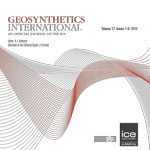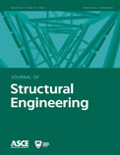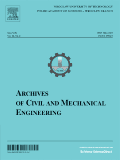
GEOSYNTHETICS INTERNATIONAL
Scope & Guideline
Catalyzing Knowledge in Geotechnical Applications
Introduction
Aims and Scopes
- Geosynthetic Material Behavior:
Research focusing on the mechanical and hydraulic behavior of geosynthetic materials, including their interactions with soil and other materials under various loading and environmental conditions. - Innovative Applications of Geosynthetics:
Exploration of new applications for geosynthetics in civil engineering, environmental protection, and infrastructure development, emphasizing practical solutions to contemporary engineering challenges. - Numerical and Analytical Modeling:
Utilization of numerical simulations and analytical models to predict the behavior of geosynthetic systems, aiding in the design and optimization of geosynthetic applications. - Durability and Environmental Impact:
Investigation into the long-term performance and environmental impact of geosynthetics, including aging, degradation, and sustainability aspects. - Field Studies and Experimental Research:
Presentation of experimental studies and field investigations that validate theoretical models and practical applications of geosynthetics in real-world scenarios. - Interdisciplinary Research:
Encouragement of interdisciplinary studies that integrate geosynthetics with other fields such as geotechnics, environmental science, and materials engineering.
Trending and Emerging
- Smart Geosynthetic Systems:
Increasing interest in the development and monitoring of smart geosynthetic materials, including sensor-enabled geosynthetics that provide real-time performance data, enhancing the ability to assess and manage geotechnical structures. - Sustainability and Eco-Friendly Materials:
A growing trend towards the use of sustainable materials in geosynthetic applications, including recycled and bio-based materials, reflects the industry's response to environmental concerns and regulatory pressures. - Advanced Numerical Modeling Techniques:
An uptick in the adoption of advanced numerical modeling techniques, including machine learning and artificial intelligence, to predict geosynthetic behavior and optimize designs, showcasing the integration of modern computational methods in geotechnical engineering. - Geosynthetics in Climate Resilience:
Emerging research on the role of geosynthetics in enhancing infrastructure resilience to climate change impacts, such as flooding and erosion, highlights the critical role these materials play in sustainable development. - Multi-Functional Geosynthetic Systems:
A trend towards developing multi-functional geosynthetic systems that serve multiple purposes, such as drainage, reinforcement, and environmental protection, indicating a shift towards more integrated solutions in geotechnical engineering.
Declining or Waning
- Traditional Geosynthetic Testing Methods:
There has been a noticeable decline in studies centered on conventional testing methods for geosynthetics, as the field shifts towards more innovative and efficient testing techniques, including numerical simulations and machine learning approaches. - Basic Geosynthetic Applications:
Research focusing on fundamental applications of geosynthetics, such as simple soil reinforcement without complex interactions, appears to be waning, reflecting a trend towards more sophisticated and multi-functional applications. - Static Analysis in Isolation:
The focus on static analysis of geosynthetic systems without considering dynamic loading conditions has decreased, indicating a shift towards understanding the behavior of geosynthetics under more realistic, changing conditions. - Geosynthetics in Low-Impact Environments:
There has been less emphasis on geosynthetic applications in low-impact or less demanding environments, as the journal increasingly highlights high-performance and environmentally challenging applications.
Similar Journals

Rock and Soil Mechanics
Advancing Knowledge in Rock and Soil MechanicsRock and Soil Mechanics is a premier academic journal published by SCIENCE PRESS focusing on the critical fields of civil and structural engineering, geotechnical engineering, and soil science. With an ISSN of 1000-7598 and transitioning to an Open Access format since 2020, the journal strives to enhance the accessibility of cutting-edge research to a global audience, making significant contributions to practices and methodologies in these crucial disciplines. Ranked in the Q2 category for Civil and Structural Engineering as well as Geotechnical Engineering and Engineering Geology, and Soil Science, it boasts respectable standings in Scopus rankings, further affirming its relevance and credibility within the scientific community. The journal not only serves as a platform for original research but also engages with the latest advances in technology and innovative applications in rock and soil mechanics, proving invaluable for researchers, practitioners, and students alike as they navigate an increasingly complex field of study.

International Journal of Engineering Research in Africa
Elevating African Engineering Research GloballyThe International Journal of Engineering Research in Africa is a pivotal academic resource for researchers, professionals, and students interested in the multifaceted field of engineering within the African context. Published by TRANS TECH PUBLICATIONS LTD, this journal facilitates the dissemination of innovative research, covering a myriad of topics in engineering, from advanced materials to sustainable practices. With an ISSN of 1663-3571 and E-ISSN 1663-4144, this publication not only fosters scholarly communication but also contributes to the global engineering discourse, as evidenced by its current Q3 ranking in the Engineering (miscellaneous) category in 2023. Operating from its base in Switzerland, the journal has been actively publishing since 2010 and continues to play a vital role in the advancement of engineering knowledge, particularly in the African landscape. Although it does not offer an open access model, the journal's commitment to quality research ensures that it remains a valuable asset for those seeking to understand and innovate within the engineering sector. Its integration in Scopus with a rank of #175 out of 307 in General Engineering further underscores its relevance and impact in the engineering community.

Electronic Journal of the Faculty of Civil Engineering Osijek-e-GFOS
Exploring New Frontiers in Civil Engineering ExcellenceWelcome to the Electronic Journal of the Faculty of Civil Engineering Osijek-e-GFOS, a prominent platform dedicated to the dissemination of innovative research in the field of civil engineering. Published by the University of Osijek, this Open Access journal has been accessible to the global academic community since 2010, facilitating the sharing of knowledge and advancements without financial barriers. With an E-ISSN of 1847-8948, the journal aims to cover a broad scope of civil engineering disciplines, including structural engineering, geotechnics, environmental engineering, and construction management, among others. It serves as a crucial resource for researchers, professionals, and students, providing them with insightful articles and studies that contribute to the development of best practices in the field. By promoting open collaboration and knowledge sharing, the Electronic Journal of the Faculty of Civil Engineering Osijek-e-GFOS stands as a testament to the commitment of the University of Osijek to enhance the field of civil engineering through impactful research and educational outreach.

Soils and Rocks
Exploring the Depths of Soil and Rock MechanicsSoils and Rocks is an academic journal dedicated to the field of Geotechnical Engineering and Engineering Geology, published by the Brazilian Association of Soil Mechanics and Geotechnical Engineering in collaboration with the Portuguese Geotechnical Society. Since becoming an Open Access platform in 2011, this journal has provided a vital publication outlet for researchers and professionals seeking to disseminate their findings on soil behavior, rock mechanics, and related topics within an international context. The journal is indexed in Scopus, holding a rank of 177 out of 229 in its category as of 2023, placing it in the 22nd percentile among its peers. Operating out of Brazil, Soils and Rocks encourages rigorous scholarly exchange and exploration of innovative practices within the sectors, making it an important resource for advancing knowledge in the geotechnical community. With a converged publication history from 2007 to 2024, the journal aims to foster significant advancements and insights that enhance our understanding of subsurface conditions and materials.

JOURNAL OF STRUCTURAL ENGINEERING
Innovative Insights for Engineering ProfessionalsThe JOURNAL OF STRUCTURAL ENGINEERING, published by the ASCE-AMERICAN SOCIETY OF CIVIL ENGINEERS, is a premier academic journal that focuses on the latest advancements in the field of structural engineering. With a rich history dating back to 1955, this journal has become a crucial platform for disseminating peer-reviewed research that addresses critical issues and innovative solutions in building and construction, civil and structural engineering, materials science, and mechanics. It proudly holds a Q1 quartile ranking across multiple categories in the 2023 Scopus rankings, indicating its influential presence in the academic community. The journal does not currently offer open access options, ensuring that the content is rigorously vetted for quality and relevance, thus appealing to researchers, industry professionals, and students seeking credible, impactful research. With contributions from leading experts, the JOURNAL OF STRUCTURAL ENGINEERING is essential reading for anyone interested in advancing their understanding and practice within this vital area of engineering.

Structural Concrete
Shaping Tomorrow's Structures with Concrete KnowledgeStructural Concrete, published by ERNST & SOHN, is a premier journal dedicated to the field of Civil and Structural Engineering, focusing on innovative research and advancements in concrete materials and technologies. With an impressive impact factor and a consistent ranking in the Q1 category of both Building and Construction and Civil and Structural Engineering, the journal stands as a vital resource for researchers, professionals, and students alike. It is indexed with notable Scopus ranks, underscoring its significance within the academic community. The journal spans a comprehensive scope (from 2001 to the present) that encompasses diverse topics related to the behavior, design, and application of structural concrete. Although not an open access publication, it offers valuable insights and cutting-edge knowledge that contribute to the ongoing evolution of construction practices and materials science. Structural Concrete is an essential platform for sharing pioneering findings and fostering collaboration within this dynamic field.

International Journal of Pavement Research and Technology
Elevating pavement practices through rigorous research.The International Journal of Pavement Research and Technology, published by SpringerNature, stands as a leading platform in the realm of civil and structural engineering, focusing on critical advancements in the field of pavement research. With an ISSN of 1996-6814 and an E-ISSN of 1997-1400, this journal serves an international audience dedicated to enhancing pavement technologies, materials, and practices. Recognized for its rigorous standards, it holds a commendable 2023 Q2 ranking in both Civil and Structural Engineering and Mechanics of Materials, showcasing its influence and relevance in these specialized areas. The journal has been actively publishing since 2009 and continues to explore innovative solutions while addressing pressing challenges in pavement engineering. Although currently not an open-access platform, the findings published within its pages are pivotal for researchers, engineers, and students striving to advance the science and technology of pavement systems. With an emphasis on quality and a commitment to the progress of engineering practices, the journal is an essential resource for those engaged in this dynamic field.

SHOCK AND VIBRATION
Innovating solutions for engineering challenges.SHOCK AND VIBRATION, published by HINDAWI LTD, is an esteemed open-access journal that has been disseminating vital research in the fields of Civil and Structural Engineering, Condensed Matter Physics, Geotechnical Engineering and Engineering Geology, Mechanical Engineering, and Mechanics of Materials since its inception in 1993. Based in Egypt, this journal has earned its place within the Q3 quartile rankings across multiple engineering and science categories, showcasing its growing influence and commitment to advancing knowledge in these domains. Accessible to a global audience, it allows researchers, professionals, and students to share findings and foster innovation without paywalls. The journal proudly contributes to a deeper understanding of shock and vibration phenomena, addressing both theoretical and practical applications essential for various engineering disciplines. As a vital resource for academics and industry professionals alike, SHOCK AND VIBRATION serves as a cornerstone for the ongoing exploration and development of cutting-edge solutions in the engineering landscape.

Geomechanics and Engineering
Empowering Engineers with Cutting-edge ResearchGeomechanics and Engineering is a premier journal published by TECHNO-PRESS that delivers high-quality research in the fields of civil and structural engineering, as well as geotechnical engineering and engineering geology. With an ISSN of 2005-307X and an E-ISSN of 2092-6219, this journal serves as a significant repository of innovative methodologies, case studies, and theoretical advancements. Located in South Korea, Geomechanics and Engineering is indexed in Scopus, where it boasts a commendable ranking of #100 out of 379 in Civil and Structural Engineering and #69 out of 229 in Geotechnical Engineering and Engineering Geology, reflecting its impact with substantial percentile rankings of 73rd and 70th, respectively. Over its converged years from 2009 to 2024, the journal aims to advance the understanding of geomechanical phenomena and their application in engineering, making it an essential read for researchers, professionals, and students committed to solving today's pressing engineering challenges.

Archives of Civil and Mechanical Engineering
Pioneering Research for Engineering FrontiersArchives of Civil and Mechanical Engineering is a distinguished peer-reviewed journal published by SpringerNature, focusing on advancing the fields of civil and mechanical engineering. With an impressive Q1 ranking in both categories in 2023, this journal caters to a global audience, addressing the evolving challenges and innovations within these vital engineering disciplines. The journal has been a pivotal platform since its inception in 2006, and it continues to be essential for researchers and practitioners seeking to publish and access high-quality research. The absence of an Open Access option ensures that published works maintain rigorous academic standards, thereby enhancing their value within institutional repositories. With a robust impact factor and high visibility on Scopus—ranking #122 out of 672 in Mechanical Engineering and #74 out of 379 in Civil and Structural Engineering—this journal is an ideal venue for professionals, researchers, and students dedicated to advancing their knowledge and contributing to cutting-edge engineering practices. Based in Germany and operating internationally, the Archives of Civil and Mechanical Engineering invites submissions that address critical issues and solutions in contemporary engineering.